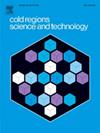Salt-frost heave development and resistance mechanisms in saline soils solidified with multiple industrial wastes
IF 3.8
2区 工程技术
Q1 ENGINEERING, CIVIL
引用次数: 0
Abstract
Salt-frost heaving of canal foundation saline soils is the primary cause of damage to the lining structures of water conveyance channels in the Hetao Irrigation District, China. Chemical solidification of saline soils can mitigate frost heave; however, application studies exploring the salt-frost heave resistance of saline soils solidified through the synergistic use of multiple industrial solid wastes in the Hetao remain limited. This study employs a sustainable solidifying material composed of slag, fly ash, coal gangue, coal-based metakaolin, carbide slag, and potassium silicate activator. The optimal mix ratio was determined using Response Surface Methodology (RSM). Unidirectional freezing tests evaluated the effects of solidification material content, curing period, and salt content on salt-frost heave development. Unconfined compressive strength tests assessed salt-frost heave durability of high-salinity solidified saline soils. Microstructural characteristics were analyzed using Scanning Electron Microscopy (SEM), Mercury Intrusion Porosimetry (MIP), X-ray Diffraction (XRD), and Thermogravimetric Analysis (TG) to investigate resistance mechanisms. Results indicated that the industrial waste materials exhibited synergistic effects in an alkaline environment, with the optimal mix ratio of slag, fly ash, coal gangue, coal-based metakaolin, carbide slag, and potassium silicate at 21:25:33:8:7:6. Increasing solidified material content and curing time significantly enhanced salt-frost heave resistance, as evidenced by improved freezing temperature stability, deeper freezing front migration, and reduced salt-frost heave rate. The optimal group (35 % solidifier, 7 days curing) showed a 5.53 °C increase in stable freezing temperature, a 3.78 cm upward migration of the freezing front, and a 3.94 % reduction in salt-frost heave rate. Salt-frost heave durability of high-salinity soils improved post-solidification, with a gradual decrease in the degradation of unconfined compressive strength, achieving a minimum weakening of 21.13 %. Hydration products C-S-H, C-A![]() H, and AFt filled voids between soil particles, restricting water and salt migration. Hydration of industrial wastes reduced free water and content, decreasing water-salt crystallization and mitigating salt-frost heave. The findings provide an engineering reference for in-situ treatment of salt-frost heaving in saline soils of water conveyance channels in the Hetao Irrigation District.
H, and AFt filled voids between soil particles, restricting water and salt migration. Hydration of industrial wastes reduced free water and content, decreasing water-salt crystallization and mitigating salt-frost heave. The findings provide an engineering reference for in-situ treatment of salt-frost heaving in saline soils of water conveyance channels in the Hetao Irrigation District.
多种工业废弃物固化盐渍土的盐冻胀发展及抵抗机制
河套灌区渠基盐渍土的盐冻胀是造成输水渠道衬砌结构破坏的主要原因。盐渍土化学固化可缓解冻胀;然而,多种工业固体废弃物协同固化盐渍土抗盐冻胀的应用研究还很有限。本研究采用由矿渣、粉煤灰、煤矸石、煤基偏高岭土、电石渣和硅酸钾活化剂组成的可持续固化材料。采用响应面法(RSM)确定最佳配比。单向冻结试验评估了凝固材料含量、养护时间和含盐量对盐冻胀发展的影响。无侧限抗压强度试验评估了高盐固化盐渍土的盐冻胀耐久性。采用扫描电镜(SEM)、压汞孔法(MIP)、x射线衍射(XRD)和热重分析(TG)等方法分析了其微观结构特征,探讨了耐蚀机理。结果表明:在碱性环境下,矿渣、粉煤灰、煤矸石、煤基偏高岭土、电石渣、硅酸钾的最佳配比为21:25:33:8:7:6,表现出协同效应;增加固化材料含量和固化时间可显著提高抗盐冻胀性,表现为提高冻结温度稳定性、加深冻结锋迁移、降低盐冻胀率。最优组(固化剂35%,固化7 d)的稳定冻结温度提高了5.53℃,冻结锋向上移动了3.78 cm,盐冻胀率降低了3.94%。高盐土的盐冻胀耐久性在固化后得到改善,无侧限抗压强度退化逐渐减小,最小减弱幅度为21.13%。水化产物C-S-H、C-AH和AFt填充了土壤颗粒之间的空隙,限制了水和盐的迁移。工业废水的水化作用降低了游离水和SO42含量,减少了水盐结晶,减轻了盐冻胀。研究结果为河套灌区输水渠道盐渍土的盐冻胀就地治理提供了工程参考。
本文章由计算机程序翻译,如有差异,请以英文原文为准。
求助全文
约1分钟内获得全文
求助全文
来源期刊

Cold Regions Science and Technology
工程技术-地球科学综合
CiteScore
7.40
自引率
12.20%
发文量
209
审稿时长
4.9 months
期刊介绍:
Cold Regions Science and Technology is an international journal dealing with the science and technical problems of cold environments in both the polar regions and more temperate locations. It includes fundamental aspects of cryospheric sciences which have applications for cold regions problems as well as engineering topics which relate to the cryosphere.
Emphasis is given to applied science with broad coverage of the physical and mechanical aspects of ice (including glaciers and sea ice), snow and snow avalanches, ice-water systems, ice-bonded soils and permafrost.
Relevant aspects of Earth science, materials science, offshore and river ice engineering are also of primary interest. These include icing of ships and structures as well as trafficability in cold environments. Technological advances for cold regions in research, development, and engineering practice are relevant to the journal. Theoretical papers must include a detailed discussion of the potential application of the theory to address cold regions problems. The journal serves a wide range of specialists, providing a medium for interdisciplinary communication and a convenient source of reference.
 求助内容:
求助内容: 应助结果提醒方式:
应助结果提醒方式:


